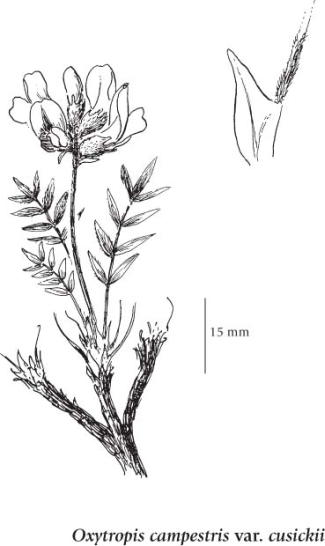Oxytropis campestris var. cusickii (L.) DC. (Greenm.) Barneby
field locoweed (Cusick's locoweed)
Fabaceae (Pea family)
Introduction to Vascular Plants
field locoweed (Cusick's locoweed)
Fabaceae (Pea family)
Introduction to Vascular Plants
Map
Distribution of Oxytropis campestris var. cusickii
Click here to view the full interactive map and legend
Species Information
General:
Perennial herb from taproot and branching stem-base, which is often covered with disintegrated stipules; densely tufted, 5-30 cm tall.
Leaves:
Basal, odd-pinnately compound, 3-30 cm long; leaflets 7 to 35 or more, lance-elliptic to oblong, silky or appressed-hairy on both surfaces to nearly glabrous above, 5-30 mm long; stipules membranous, 5-15 mm long, fringed with long hairs along the edges and long-hairy on the lower surface.
Flowers:
Inflorescence a spike-like to head-like raceme of 5 to 30 pea-like flowers, the raceme-stalks spreading to erect, to 30 cm long; corollas white to yellowish, sometimes tinged with purple, 10-18 mm long; calyces cylindrical, with mixed grey and black hairs, the triangular to linear teeth 1-3 mm long.
Fruits:
Pods, oblong-ellipsoid, erect to spreading, membranous, short-hairy, 1-2.5 cm long, almost 2-chambered, the beak 5 mm long.
Illustration

If more than one illustration is available for a species (e.g., separate illustrations were provided for two subspecies) then links to the separate images will be provided below. Note that individual subspecies or varietal illustrations are not always available.
Illustration Source: The Illustrated Flora of British Columbia
Ecology
Ecological Framework for Oxytropis campestris var. cusickii
The table below shows the species-specific information calculated from
original data (BEC database) provided by the BC Ministry of Forests and Range.
(Updated August, 2013)
The table below shows the species-specific information calculated from
original data (BEC database) provided by the BC Ministry of Forests and Range.
(Updated August, 2013)
| Site Information |
Value / Class |
||
|
Avg |
Min |
Max |
|
| Elevation
(metres) |
1215 | 250 | 2490 |
| Slope
Gradient (%) |
23 | 0 | 67.5 |
|
Aspect (degrees) |
182 | 10 | 360 |
| Soil
Moisture Regime (SMR) [0 - very xeric; 4 - mesic; 8 - hydric] |
2 | 0 | 5 |
| Modal
Nutrient Regime
Class |
C | ||
| #
of field plots species was recorded in: |
138 | ||
| Modal
BEC Zone Class |
IDF | ||
|
All BEC Zones (# of stations/zone) species was recorded in |
AT(17), BAFA(3), BG(14), BWBS(5), ESSF(21), ICH(1), IDF(37), IMA(2), MS(2), PP(35), SWB(1) | ||
|
Source:
Klinkenberg 2013
|
|||
Habitat and Range
Dry to mesic sandy, gravelly or rocky sites, including river bars, terraces, rock outcrops, grassy slopes, meadows, clearings, roadsides, alpine tundra and heath, and open forests in the steppe, montane, subalpine and alpine zones; locally common in SC BC (var. cusickii), rare in SC and SE BC (var. columbiana) and frequent in extreme N BC, the Queen Charlotte Islands and N Vancouver Island (var. varians); var. columbiana - S to WA, ID and MT; var. cusickii - E to SW AB and S to N CO, ID and OR; var. varians - N to AK, YT and NT.Status Information
| Scientific Name | Origin Status | Provincial Status | BC List (Red Blue List) | COSEWIC |
|---|---|---|---|---|
| Oxytropis campestris var. cusickii | Native | S5 | Yellow | Not Listed |
| Oxytropis campestris var. davisii | Native | S3? | Yellow | Not Listed |
| Oxytropis campestris var. jordalii | Native | S3? | Blue | Not Listed |
| Oxytropis campestris var. spicata | Native | S5 | Yellow | Not Listed |
| Oxytropis campestris var. varians | Native | S5 | Yellow | Not Listed |
BC Ministry of Environment: BC Species and Ecosystems Explorer.
Synonyms
Synonyms and Alternate Names:
Oxytropis alpicola (Rydb.) M.E. Jones
Oxytropis campestris var. rydbergii (A. Nels.) R.J. Davis
Oxytropis cusickii Greenm.
Oxytropis rydbergii A. Nels.